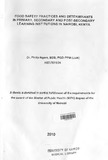| dc.contributor.author | Ngere, Philip | |
| dc.date.accessioned | 2016-06-23T11:49:16Z | |
| dc.date.available | 2016-06-23T11:49:16Z | |
| dc.date.issued | 2010 | |
| dc.identifier.uri | http://hdl.handle.net/11295/96312 | |
| dc.description.abstract | Every year millions of people worldwide suffer food borne illnesses making it a major public health concern. The learning institutions are at a great risk of food borne illnesses due to their student population that require mass catering which has inherent risks associated with bulk handling of food. Furthermore, the food handlers who carry out the food service processes within the institutions are
critical to food safety outcomes hence their food safety knowledge and practices
i need to be monitored. Finally, the adequacy and reliability of institutional financing determines its ability to source safe food items, procure necessary food safety equipments and to hire appropriate personnel.
The general objective was to determine the food safety practices and their determinants in primary, secondary and post-secondary learning institutions of Nairobi and to suggest ways of improving food safety outcomes.
This was a cross-sectional study employing quantitative methods. The study was carried out in Nairobi Kenya which had 110 learning institutions with feeding programmes. These were first stratified based on their level of education into primary, secondary and post-secondary and then based on ownership into public and private institutions. A proportionate stratified random sampling method was used to select 30 institutions for the study. The study utilized Knowledge Assessment Questionnaire (KAQ), Practice Observation Checklist (POC) and Equipment Evaluation Log (EEL) to collect data. The mean percentage scores for every institution was then calculated and entered into the Predictive Analytic Soft Ware (PASW) statistical programme which was also used to carry out the descriptive and associational analyses of the study variables.
A total of 30 institutions participated of which 43.3% were primary schools and 63.3% were private institutions. The mean percentage score for food safety practices for all the institutions was 48.7%. This, however, varied across the level
and ownership of the learning institutions. The latter turned out to be a significant determinant of food safety knowledge (p=0.017), food safety equipment (p=0.000) and food safety practices (p=0.001).
The study established that food handlers’ food safety knowledge is an important determinant of food safety practices. The conditions of the food safety equipments also had a positive association with the food safety practices within the institutions. While the institutional ownership directly affects the food safety practices with privately funded institutions having better food safety practices, the level of institution has no direct influence on the food safety practices.
There is need to empower the food handlers with the correct knowledge on food safety. The functional conditions of the food safety equipments within the institutions also need to be improved. The policy makers in the education sector need to develop job placement criteria for food handlers setting minimum academic, professional and experience requirements. | en_US |
| dc.language.iso | en | en_US |
| dc.publisher | University of Nairobi | en_US |
| dc.rights | Attribution-NonCommercial-NoDerivs 3.0 United States | * |
| dc.rights.uri | http://creativecommons.org/licenses/by-nc-nd/3.0/us/ | * |
| dc.title | Food safety practices and determinants in primary, secondary and post-secondary learning institutions in Nairobi, Kenya | en_US |
| dc.type | Thesis | en_US |
| dc.description.department | a
Department of Psychiatry, University of Nairobi, ; bDepartment of Mental Health, School of Medicine,
Moi University, Eldoret, Kenya | |



